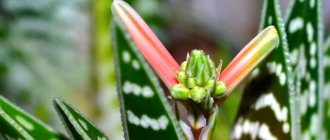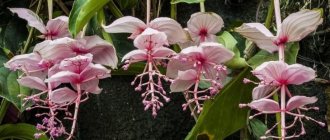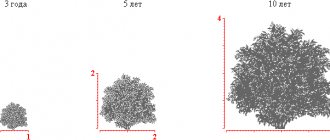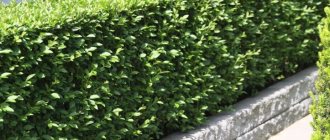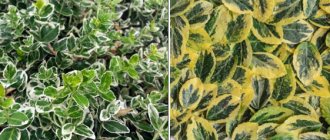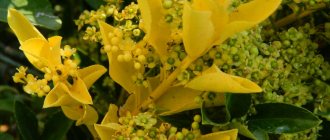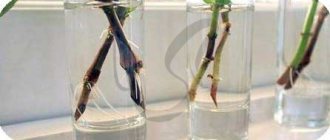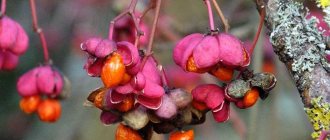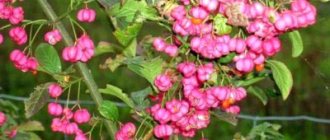Description of the plant
The height of the bush is approximately 3 meters, over the year the plant gains about 15 cm in height. The bush has an interesting, unusual bark, cork wings , which are located at the edges of the shoots. This look creates the impression of airiness and lightness.
The leaves are arranged oppositely, the leaf shape resembles an ellipse. The leaves are green on the outside and light on the inside. Leaf length is approximately 4 cm.
In autumn, the leaves change their color to purple with a red tint or burgundy.
The most active flowering time is in May and June; it blooms with unusually beautiful greenish-yellow flowers .
Unfortunately, these flowers are hardly noticeable when viewed from afar.
Euonymus bears fruit in the autumn-winter period. When its leaves are still green, the fruits stand out especially beautifully against the background of greenery. If you look at the bush from a distance, you might think that these are not fruits at all, but the flowers of the plant.
Its fruits have an unusual original reddish tint and a leathery capsule; when ripe, it acquires the color of a real tangerine. These boxes remain hanging on the branches of the plant much longer than the leaves themselves, and remain on it for almost the entire winter season.
INTERESTING TO KNOW! When the time comes and the leaves change color, the boxes burst at the seams, forming a kind of parachutes, under which the seeds hang like parachutists. They are carried by the wind, which is how the plant reproduces. Its seeds are covered with a yellowish peel.
Only the euonymus has such unique fruits. By the way, they are not as toxic as is commonly believed, but still, they contain poisonous alkaloids . In order for an adult to become poisoned by these fruits, they must be eaten in large quantities.
And since they don't taste good, it would be very difficult to ingest enough to cause serious poisoning. In small doses, the fruit causes vomiting and diarrhea. And which adult would even think of eating them? Children can try it out of curiosity, but here we need to make sure that children don’t taste it.
NOTE! In addition to the winged one, there are several more varieties of euonymus: the unique Japanese one, the dwarf one - ideal for growing at home, the beautiful European one and the unpretentious warty one.
Kinds
The genus Euonymus includes 220 species, among which there are deciduous and evergreen shrubs and trees with a poisonous nature. Some of them reach 10 meters in height, but there are also dwarf representatives of the genus, barely reaching 70 cm. The decorative value of the plant lies in its openwork crown, woven from small opposite green leaves, decorated with white or yellow spots. When autumn comes, the leaves dramatically change their color and the bushes of the plant flare up with yellow, red , pink fire.
Scarlet euonymus - a real decoration of the autumn garden
Euonymus is decorated with dark green, jagged, shiny leaves.
Since the plant most often grows in open ground, winter-hardy euonymus species that tolerate our harsh winters are suitable for the temperate zone. Some varieties are grown at home, but in the garden the beauty of the plant is revealed better.
Euonymus is ideal for landscaping
With the help of euonymus you can change your garden beyond recognition
For example, euonymus fortunena , which grows in the southern regions of China, Ukraine and the Caucasus, is suitable for home cultivation and tolerates frosty winters in the garden. A low shrub with variegated leaves, it belongs to the evergreen plant species. Loves sunlight and high humidity.
Euonymus Fortune
Fortune's euonymus can be modeled in any way you like, since the plant does not get sick after pruning and takes any shape
European euonymus , which grows up to 6 meters, is suitable for open ground This beautiful tree looks great in single plantings and is used in hedges. Frost-resistant and light-loving, this type of euonymus is actively used by designers for landscape . It is especially good in the fall, when the crown is strewn with open pink fruit boxes and red leaves.
Euonymus is especially beautiful in autumn
European euonymus will become a spectacular resident of your garden
In the design of lawns you can often find winged euonymus , a tree with a highly branched crown and shiny dark green leaves. Grows up to 4 meters, winter-hardy, prefers partial shade and moderately moist soil.
Stately and slender winged euonymus
Euonymus is a wonderful way to add bright and rich colors to your garden.
Among the unpretentious, shade-tolerant species, warty euonymus , which received its name for its shoots and branches strewn with warts. The flowers are brown, the leaves are light green, turning pink in the fall, making the plant especially attractive.
Euonymus warty
Japanese euonymus is planted in city parks and alleys , which calmly tolerates air pollution. A very beautiful plant, decorated with dark green leaves with a yellow border. Under natural conditions it can reach up to 7 meters in height. Fruits in September.
Japanese euonymus
Most types of euonymus have similar care requirements, with slight deviations in some parameters.
Photo
The appearance of the winged euonymus is shown in the photo below:
Origin and appearance of the winged euonymus
First found in southeast Asia, it is classified as a member of the Euonymus family. It grows up to 4 m in height in the wild, and ornamental varieties up to 1.2 m. The crown can reach 3 m in diameter.
Euonymus winged in autumn
Flowering occurs at the end of May, when white flowers appear, small with a greenish tint. But most of all, the beauty of the plant is manifested in the autumn, when the crown turns red with a purple tint and the fruits ripen. The main value of an ornamental plant is the size and shape of the crown. Its formation requires skill and constant care. The euonymus mix looks beautiful in a flowerbed or in a pot.
Advantages and disadvantages
Among the advantages it is worth noting:
- Among the main advantages of the shrub is its frost resistance . Even with severe frosts, the plant does not freeze.
- Good tolerance to smoke and air pollution allows it to be grown even in urban conditions.
- Not picky about fertilizers , tolerates a variety of types of fertilizers.
- The acidity of the soil is not particularly important for this shrub; the main thing is that it is fertile and well dended.
- With proper care of the shrub, you can get a lush and dense crown.
- The winged euonymus has rightfully earned popularity among landscape designers, since thanks to the color of its leaves and shoots it will stand out noticeably among many other plants. In addition, the fact that it can grow quite large and “fluffy” will make it possible to create it as the main object and source of pride in a garden or other area.
- Its contrast attracts and fascinates, and the fruits, which have changed color from reddish to orange, appear to be flowers, and this gives the impression that the euonymus is able to bloom throughout the year.
- The main feature of the Winged Euonymus, and in fact what fully explains its name, is its beautiful fruits. They are located in a box and when it opens it will fly away, carried away by the wind.
Minuses:
- Euonymus does not like shade and the best place for it would be a separate place without being surrounded by other large plants that cast shadows on it.
- The shrub is picky about the watering regime . Therefore, you need to constantly look after it in dry weather and provide high-quality drainage.
- This shrub grows quite slowly.
Main varieties
The most popular subspecies among designers and gardeners is the winged euonymus Compactus. The height of this plant in rare cases reaches one meter. At the same time, the crown extends two to three meters in width and looks simply amazing. The Compactus variety grows extremely slowly, giving an average annual growth of six to seven centimeters. This euonymus is characterized by a very vulnerable root system, so when working in the garden you need to take into account the location of the bush.
Another notable euonymus variety is Macrophilis. This name is translated as “long leaves”. Indeed, this plant has quite large foliage.
Also, many designers and florists fell in love with the Chicago Fire variety . This name is also quite fair, since with the arrival of autumn the crown of this variety lights up with bright orange or red leaves, like a real fire. The tree is small - up to one and a half meters. The crown of the Chicago Fire euonymus is round and compact, with horizontal branches.
Landing
Euonymus is planted in spring or early autumn.
It is advisable that the landing area be shaded. We should avoid areas with high groundwater levels. Euonymus grows profusely, so the site must be selected at some distance from buildings and trees. Before planting, you need to properly prepare the soil. Euonymus loves porous, light soil with good water permeability. In case of increased acidity in the soil, it should be limed.
The hole for planting must be dug in advance , at least two weeks before the planned planting date. In volume it should be one and a half to two times larger than the root system of the seedling.
The bottom of the pit can be drained using sand and the top layer of soil removed from the pit with the addition of compost.
Next, add a little lime to the hole to reduce the acidity of the soil.
Carefully lower the seedling into the hole, straighten the roots and cover it with a mixture of soil and compost, gradually compacting it. The root collar of the euonymus should ultimately be flush with the surface of the site.
Immediately after planting, you need to water around the seedling. When the earth settles, it is worth adding some more.
Care
Euonymus is not particularly picky about lighting and temperature conditions. It is frost-resistant and easily tolerates temperature changes. You can plant it in a shaded area, but plenty of sunlight does not harm it either.
Watering should be done as needed. In dry weather, in the complete absence of rain, the soil should be moderately moist. This plant does not really like waterlogging, so during prolonged rains there is no need to water the euonymus at all. A slightly larger volume of moisture is required in the initial stages, while the shoots are still very young.
During the spring-summer period, fertilizing should be done approximately once every 12-15 days. Fertilizers are suitable both mineral and organic.
To give euonymus bushes a varied shape, you can trim off branches on the crown that have reached a certain height. This is usually done in the spring.
Carefully! Euonymus sap is poisonous. Therefore, it is necessary to observe safety precautions when pruning - work carefully, preferably wearing special gloves.
It is important to monitor the condition of the soil, periodically loosen the soil and promptly remove weeds that have sprouted nearby.
Only young seedlings (up to 3 years old) need to be prepared for winter. They can be covered with fallen leaves or spruce branches. More mature plants do not need special attention in winter: you can limit yourself to mulching with leaves or sawdust.
GOOD TO KNOW! In addition to euonymus, there are no less beautiful ornamental shrubs, such as: Skimmia, Leptospermum, Broom. Look! Perhaps they will also decorate your home or garden.
Useful tips
Caring for euonymus is not difficult. But experts advise adhering to several rules:
- Watering should be moderate. This shrub often suffers from stagnant water. Thorough watering is required only during feeding and replanting and in extreme heat. Young shrubs also need a little more water.
- Do not forget to weed the weeds and loosen the soil from time to time, because good aeration is very important for winged euonymus. But fluffing up the soil and removing weeds must be done as carefully as possible, otherwise the plant can be damaged.
- It is better to do complex fertilizer for euonymus in early spring, mid-summer and at each replanting. Euonymus needs nutritious soil.
- Sanitary circumcision is carried out in March-April before the start of the sap flow period. Damaged, dry and growing branches are cut off.
- Despite the fact that euonymus is a heat-loving shrub, it tolerates cold weather well, without needing shelter in winter. The plant can withstand frost down to -24 degrees. However, it is better to protect young seedlings from harmful effects by covering them with spruce branches and agrofibre.
- Euonymus has a lot of pests. These include aphids, mites, apple moths, and all kinds of caterpillars. Also the bush is more prone to gray rot and powdery mildew. Some experts use a trick - they plant euonymus so that it attracts pests and distracts them from other plants.
Reproduction
Cuttings
- At the beginning of summer, in June or early July, from an adult plant (preferably 4-5 years old), we cut off a certain number of upright shoots up to 7 cm long, preserving the internodes. It is necessary to cut at an angle.
- We treat cut wounds on the branches of the mother bush, and treat each cut of the cutting with a growth stimulator for proper formation of the root system.
- We place the cuttings in a nutrient medium containing peat and sand. It is advisable to place the shoots in conditions of high temperatures. Ideally - in a greenhouse.
- In about a month, the first shoots will appear, and by the beginning of autumn a powerful root system will form. Now the cuttings can be transplanted to their place of growth.
Important! The main factor for successful euonymus cuttings is the absence of damage to the stem. In addition, you need to monitor soil moisture and avoid early contact with sunlight.
Seeds
- To begin with, you should keep the seeds in moistened sand for 3-4 months. The temperature should not be higher than 3°C.
- Clean the seeds and place them in a low concentration manganese solution for a couple of hours.
- Plant in soil with abundant humus and sand.
- Keep the seeds under film for rooting for two months.
- Continuously maintain soil moisture.
Diseases and pests
Almost all varieties of this shrub are prone to attack by insect pests and diseases .
If spraying with chemicals , the best time to control and combat pests is from mid-spring to early summer .
If the lesion is small, then the infected branches can be cut off.
Powdery mildew is one of the most common fungal diseases.
This is usually a milky white or gray-brown coating on the top of the foliage, which often causes yellowing of the foliage and, in more advanced cases, leads to the death of the plant.
The disease is very difficult to track, it is better to immediately take up prevention, it is easier, and in the end it will be cheaper
IMPORTANT! The bush must receive the required amount of sunlight.
Ensure good air circulation at the planting site and a minimum level of humidity around the foliage. Overhead watering should be avoided if possible.
In spring, shrubs should be treated with antifungal agents that can prevent the occurrence of disease and the appearance of harmful organisms and parasites.
With due diligence in care, since the plant is not the easiest to care for, euonymus will delight you and become a real star on your site, to the envy of your neighbors.
Use in landscape design
Due to the fact that euonymus survives well in our climate, it is often used as a decoration element:
- A “hedge” made from this plant and weaving borders with it will give a very unusual and beautiful look to the summer cottage.
- Due to its bright, rich color, euonymus will be a “fresh note” in combination with compositions from other shrubs and trees.
- By interspersing euonymus with rose bushes and rose hips, you can achieve a unique design for a small alley in front of your house.
- The proximity to flowers does not interfere with the roots of the euonymus, so a flower bed with it in the center will look great.
